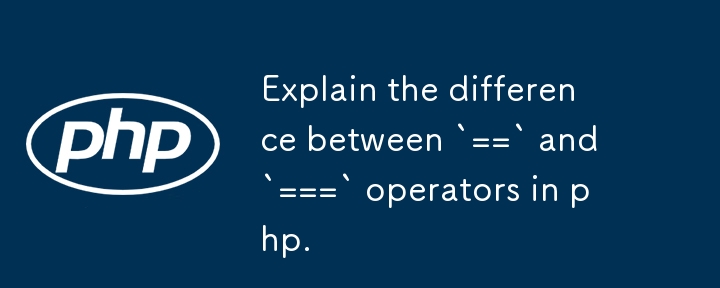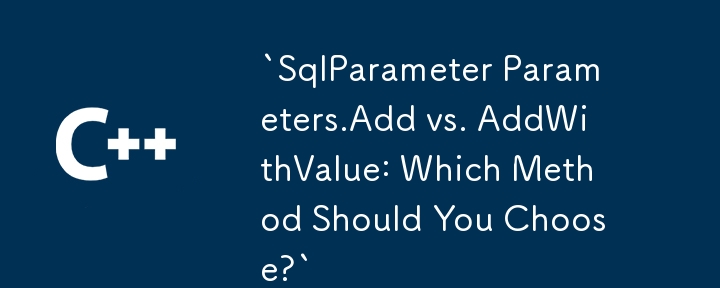Found a total of 10000 related content

Explain the difference between `==` and `===` operators in php.
Article Introduction:The difference between == and == in PHP is that: == is a loose comparison, only the values ??are compared and type conversion is performed, for example, 0=="0" is true; while === is a strict comparison, which compares both values ??and types, such as 0==="0" is false. Common type conversion rules include converting a string to a number when compared to a number, converting a Boolean value to 0 or 1, etc. It is recommended to use === first to avoid unexpected errors. For example, when checking the return value of strpos(), you must use === to determine whether it is false.
2025-07-12
comment 0
1023

php add days to date
Article Introduction:It is recommended to use the DateTime class to add a number of days to dates in PHP, with clear code and flexible functions. The DateTime class introduced in PHP5.2 supports object-oriented operations. The example code is: $date=newDateTime('2024-10-01'); $date->modify('5days'); echo$date->format('Y-m-d'); The output result is 2024-10-06; this method is highly readable and supports time zone setting and formatting output. You can also use strtotime() to implement it, but you need to pay attention to the time zone problem. The example is: $newDate=date("
2025-07-05
comment 0
800

Methods to efficiently determine whether there are multiple different values in PHP arrays
Article Introduction:This article will explain in detail how to efficiently determine whether there are multiple different values in PHP arrays. By using the array_count_values() function, we can quickly count the number of occurrences of each value in the array, and then determine whether the original array contains more than one unique value by checking the number of elements in the result array. This approach is especially suitable for scenarios where array elements need to be homogeneous, such as verifying that the seller ID in the order is consistent.
2025-08-05
comment 0
653

Explain CSS specificity and how it is calculated
Article Introduction:CSS refers to the weighting mechanism used by the browser to determine which style rules are preferred. When multiple rules act on the same element, a high-weight rule takes effect. For example, #mainp is more specific than p, and will cover the color blue. The calculation method is based on the selector type and is divided into four levels: a is the number of inline styles, b is the number of ID selectors, c is the number of classes, attributes, and pseudo-classes, and d is the number of elements and pseudo-elements. Compare bit by bit when comparing, and compare a→b→c→d in sequence like a phone number. Common misunderstandings include abuse!important, over-necking selectors, dependency ID selectors, etc. It is recommended to use clear structure and unified class name naming to reduce conflicts, and you can check the style coverage through the developer tool and adjust the selector rights.
2025-07-24
comment 0
187

How to profile WordPress performance
Article Introduction:1. Use performance analysis plug-in to quickly locate problems. For example, QueryMonitor can view the number of database queries and PHP errors, BlackboxProfiler generates function execution reports, and NewRelic provides server-level analysis; 2. Analyzing PHP execution performance requires checking time-consuming functions, debugging tools usage and memory allocation, such as Xdebug generates flame graphs to assist in optimization; 3. Monitor database query efficiency can be checked through slow query logs and index checks, QueryMonitor can list all SQL and sort by time; 4. Combining external tools such as GooglePageSpeedInsights, GTmetrix and WebPageTest to evaluate front-end plus
2025-07-07
comment 0
505

How do I use the beforeAction() and afterAction() methods in a controller?
Article Introduction:beforeAction() is used in Yii2 to run logic before the controller action is executed. If permission checks or requests modification, it must return true or parent class call to continue execution; afterAction() is run after the action is executed and before the response is sent, which is suitable for output modification or logging. 1.beforeAction() is run before the action is executed, and can be used for user permission verification. For example, redirecting the unlogged user to the login page, you need to return parent::beforeAction($action) or true to continue the process, otherwise the action execution will be prevented; 2. You can skip the check of a specific action by checking $action->id; 3. AfterAc
2025-07-02
comment 0
864

php format duration in hours minutes seconds
Article Introduction:To convert the total number of seconds to the hour:minute:second format, PHP provides two common methods. The first is to use basic mathematical operations: obtain the hours by dividing by 3600, continue to calculate the minutes and seconds after taking the modulus, and finally format the output with sprintf(); the second is to use the DateInterval class to achieve object-oriented formatting with DateTime. If the time length of more than 24 hours is required, it is recommended to calculate the hour part by yourself to avoid the limit of %H to only display the number of hours within the day. For example, 90061 seconds can be converted to 25:01:01. Select the right method according to your needs to complete the conversion.
2025-07-04
comment 0
624

How to Sort Arrays in PHP
Article Introduction:It is always easier to process sorted data to extract specific information, otherwise you have to iterate through each element of the array one by one.
For example, suppose you store the grades of different students in an array or table. If the data are not sorted by the grades obtained, you must check the grades of each student in the class to determine who gets the highest and lowest scores. If the table has been sorted from low to high by grades, you can know the lowest score by simply checking the first student’s grades.
This article will introduce the following PHP array sorting methods:
Sort arrays by value
Sort associative arrays
Sort array elements by value using user-defined functions
Sort array by key
Sort PHP multidimensional arrays
Sort using user-defined functions
Multi-column sorting
Sort by many
2025-03-03
comment 0
679


Dave The Diver: How To Catch Spider Crabs
Article Introduction:In Dave The Diver, there are some creatures that are not easy to catch. Or, catch alive that is. The spider crab is one of those very species, making it seem like the only way to bring these crustaceans back up to land is to viciously crack them up w
2025-01-10
comment 0
905

Prepare for Interview Like a Pro with Interview Questions CLI
Article Introduction:Prepare for Interview Like a Pro with Interview Questions CLI
What is the Interview Questions CLI?
The Interview Questions CLI is a command-line tool designed for JavaScript learners and developers who want to enhance their interview
2025-01-10
comment 0
1519

Soft Deletes in Databases: To Use or Not to Use?
Article Introduction:Soft Deletes: A Question of DesignThe topic of soft deletes, a mechanism that "flags" records as deleted instead of physically removing them, has...
2025-01-10
comment 0
1116



















